About BERMS
The Boreal Ecosystem Research and Monitoring Sites (BERMS) are located in the southern edge of the boreal plains ecozone in Saskatchewan, Canada. The four BERMS sites, covering 4 different forest vegetation types common to the Boreal Plains are: Fen, Old Jack Pine (OJP), Old Black Spruce (OBS), and Old Aspen (OA). ‘Old’ refers to the monitoring site being located within a mature stand of trees. The Old Aspen site ended operations in 2017 and has since been decommissioned.
The locations of each site are shown below. Monitoring at the BERMS sites includes two main components: meteorological measurements, and flux measurements (carbon, water, and energy fluxes). The majority of the meteorological and flux instruments are attached to a scaffold tower, stretching to twice the height of the trees.
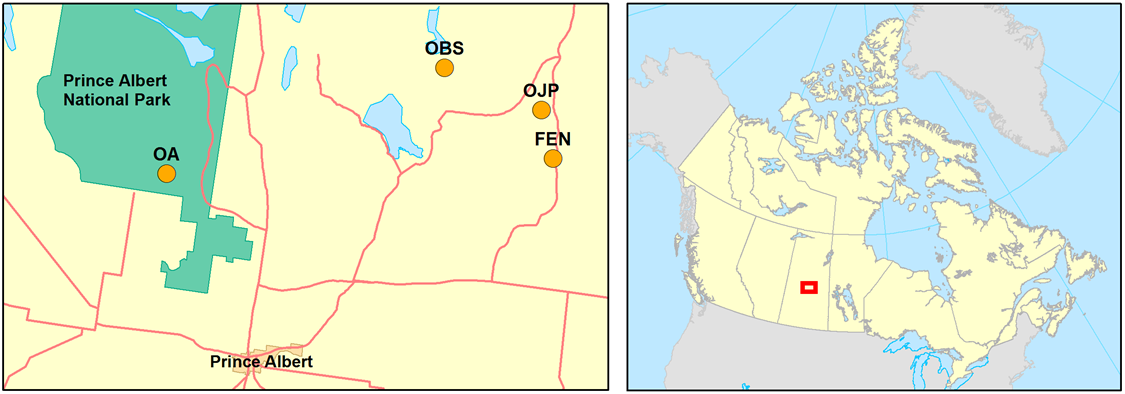
BERMS Objectives: The goal of the Global Institute for Water Security program at BERMS is to improve understanding of the interactions between climate, hydrology and vegetation in the southern boreal forest, and the sensitivity of the ecosystem to climate change.
BERMS Climate: Average temperature is -17.9°C in January, 16.2°C in July; Annual precipitation is 467mm (30% as snow)
BERMS Data: Long-term meteorological and flux data (30 min averaging). The data has been quality controlled and gap-filled using standardized procedures.
List of Measured Variables:
- Radiation (Longwave, Shortwave, Photosynthetic)
- Carbon and water fluxes
- Air temperature
- Relative humidity
- Wind speed/direction
- Barometric pressure
- Precipitation
- Soil moisture and soil temperature
- Snow depth and snow temperature
- Tree bole temperature
- Groundwater depth
Sites
Fen
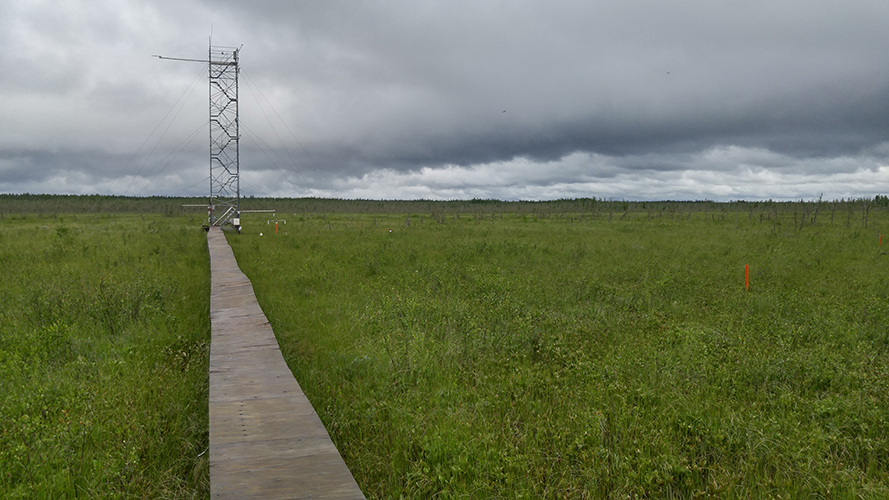
The Fen site (53.802°N, 104.618°W) is located approximately 115 km northeast of Prince Albert, Saskatchewan. The site is a minerotrophic patterned fen located in an open depression within Pleistocene glacial deposits. The entire fen is orientated northwest-southeast and contains 8.5 km2 of peatland. The depth of the peat varies from 2 to 3 m in the center to 1 m near the edges. The dominant herbaceous plants are buckbean (Menyanthes trifoliate) and several sedge species (Carex and Eriophorum spp.). The dominant woody species are scattered bog birch (Betula pumila) and tamarack (Larix laricina (Du Roi) K. Koch). The water table is generally at or above the peat surface except in very dry years.
Old Jack Pine
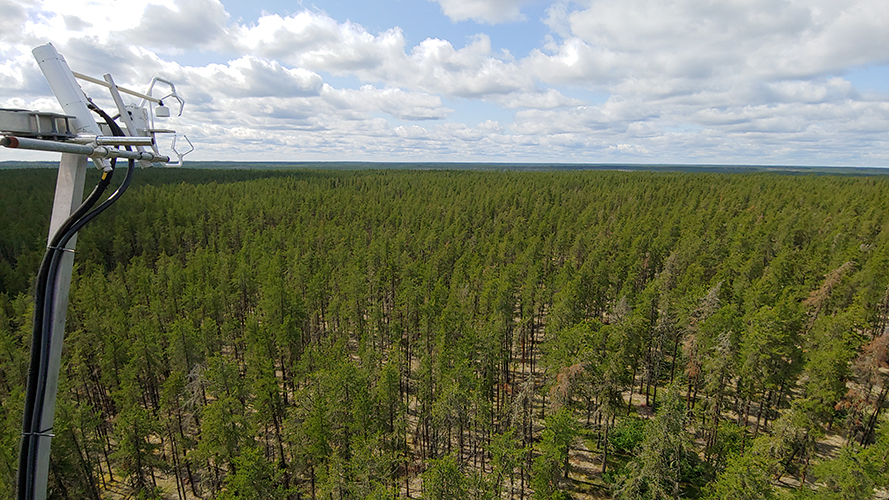
The Old Jack Pine (OJP) site (53.916°N, 104.692°W) is located about 150 km northeast of Prince Albert, Saskatchewan. The dominant species is jack pine (Pinus banksiana Lamb.). The dominant understory ground cover is a reindeer lichen (Cladina mitts [Sandst.] Hale & Culb) with isolated groups of green alder (Alnus crispa [Ait.] Pursh) and feathermoss (Pleurozium spp.). The stand was established by natural regeneration after a forest fire in 1929. The soil is a degraded Eutric Brunisol/Orthic Eutric Brunisol and the site topography is relatively flat with few gently rolling ridges.
Old Black Spruce
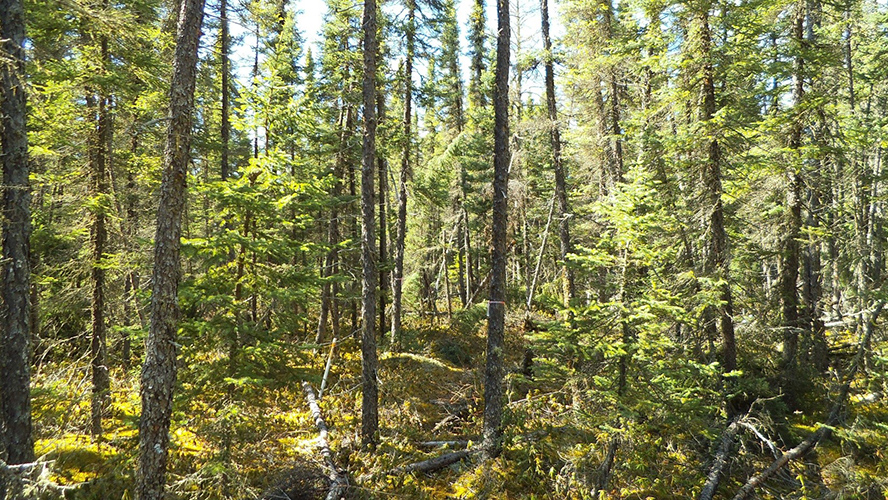
The Old Black Spruce (OBS) site (53.987oN, 105.118oW) lies approximately 100 km northeast of Prince Albert, Saskatchewan. The stand was established by natural regeneration after a forest fire in 1879. The dominant species is black spruce (Picea mariana (Mill.) B.S.P. 90%), with ~10% tamarack (Larix laricina (Du Roi) K. Koch). The surface is relatively flat with a hummock-hollow micro topography in wetter areas with occasional surface water in the hollows. The soil is Peaty Orthic Gleysol with a 20-30 cm thick forest-floor comprising of hummocky peat (Sphagnum spp.) in wet areas and feather mosses (Hylocomium Splendens) and lichens (Cladina spp.) in drier areas. The water table is elevated most of the year.
Old Aspen (Decommissioned)
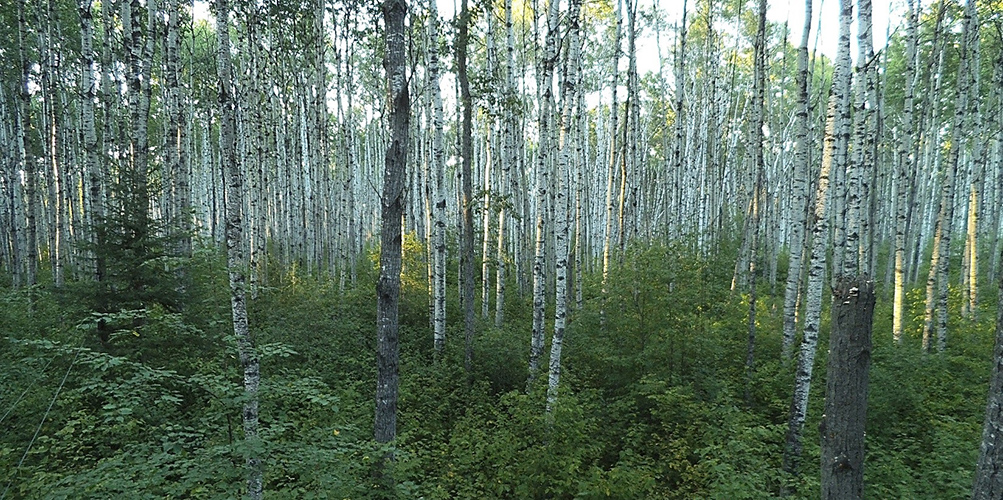
The Old Aspen (OA) site (53.629°N, 106.198°W) was located in Prince Albert National Park near the southern edge of the boreal forest. The forest stand was established by natural regeneration after a forest fire in 1919. The forest canopy has two distinct layers: an overstory of trembling aspen (Populus tremuloides Michx. 95 %) with a few balsam poplar (Populus balsamifera L. 5 %) and a 2-m understory of dense hazelnut (Corylus cornuta Marsh.). The soil is an Orthic Gray Luvisol, and the topography is gently rolling. The OA site ended operations in 2017 and has been decommissioned.
History
Over 20 years of continuous, high quality meteorological and flux data!
The Boreal Ecosystem Research and Monitoring Sites (BERMS) have a rich history. The project was originally designed as a partial follow-up to the BOREAS (Boreal Ecosystem-Atmosphere Study) experiment. BOREAS data was collected from 1994–1996. The BERMS program began in 1997 and was originally operated and funded by Environment and Climate Change Canada, Natural Resources Canada, and Parks Canada. Since 2012, operations have predominately been funded by the Global Institute for Water Security (GIWS), with the University of Saskatchewan overseeing the OJP and Fen sites, and the University of British Columbia overseeing OA and OBS. BERMS has been a participant of Fluxnet Canada, AmeriFlux, and the Canadian Carbon Program and are part of the Changing Cold Region Network (CCRN).
As of 2018, the Global Institute for Water Security along with the University of Saskatchewan have taken over the operation and funding of the OJP, Fen, and OBS sites. The OA site ended operations in 2017 and has been decommissioned.
Contact
Research and site visits to BERMS are very much welcomed! We just need some information before approval is granted.
If you are interested in conducting research activities or would like to visit the OJP, Fen, or OBS sites please contact bruce.johnson@usask.ca with the following information:
- Contact name
- Contact email
- Contact organization
- Site(s) you are interested in
For site visits please include the date(s) you are interested in.
For research activities please include the following:
- Brief description of the research to be conducted
- Instrumentation to be installed
- Time frame of research
- Decommissioning and exit strategy
Bruce Johnson
Global Institute for Water Security
University of Saskatchewan
bruce.johnson@usask.ca
Warren Helgason
Department of Civil, Geological and Environmental Engineering
University of Saskatchewan
warren.helgason@usask.ca
Alan Barr
Global Institute for Water Security
University of Saskatchewan
alan.barr@usask.ca
Andrew Ireson
Global Institute for Water Security
University of Saskatchewan
andrew.ireson@usask.ca
Colin Laroque
College of Agriculture and Bioresources
University of Saskatchewan
colin.laroque@usask.ca
If you would like to aquire BERMS data for research purposes please contact bruce.johnson@usask.ca and your request will be forwarded to our data management team.
Please include the following details in your request:
- Site(s)
- Data type
- Time frame
- Purpose
